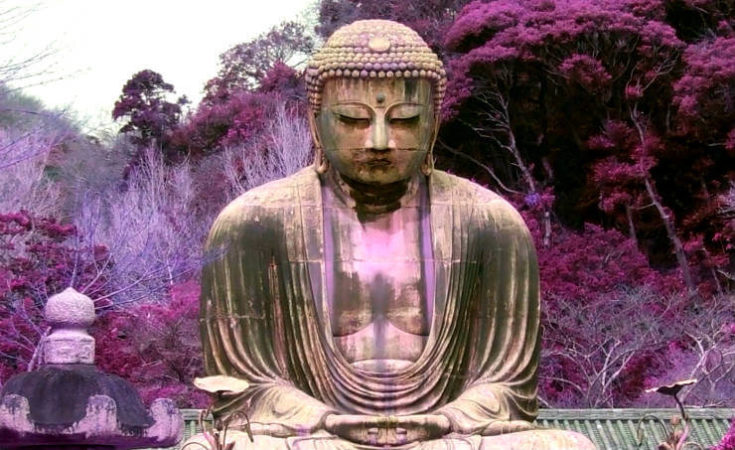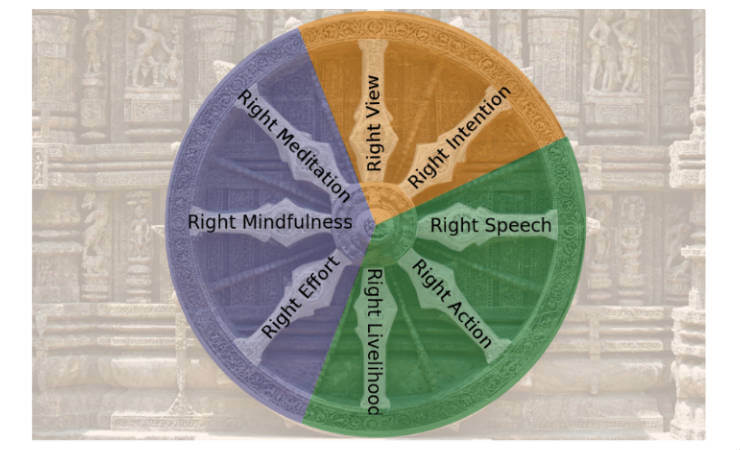
What are The Four Noble Truths?
The Four Noble Truths are the first thing the Buddha taught after becoming Enlightened; it was his first sermon. The Noble Truths are the most basic concepts in Buddhism.
When Siddhartha Gautama (circa 563-483 BCE) sat under the Bodhi Tree in Bodh Gaya in India, he swore to not get up until he reached Enlightenment.
He said,
Here on this seat my body may shrivel up, my skin, my bones, my flesh may dissolve, but my body will not move from this seat until I have attained Enlightenment, so difficult to obtain in the course of many kalpas.
A kalpa is an immense period of time – 4320 million human years.
Siddhartha did become Enlightened in Bodh Gaya and when he did, he became the Buddha – He who is awake. Today this place is a sacred pilgrimage where Buddhists come from all over the world.
The Buddha’s first sermon was given at the Deer Park in Sarnath (South of modern day Nepal and near the confluence of the Ganges and Gomati rivers).

The sermon is known as the Dhammacakkappavattana Sutta which means, ’The Setting in Motion of the Wheel of Dharma.’ This is where he presented the Four Noble Truths.
What are The Four Noble Truths?
1. The truth of suffering (dukkha)
2. The truth of the cause of suffering
3. The truth of the end of suffering
4. The truth of the path that leads to the end of suffering
In his first sermon, the Buddha said,
Now this, O monks, is the noble truth of suffering: birth is suffering, old age is suffering, death is suffering, sorrow, grieving, dejection, and despair are suffering. Contact with unpleasant things is suffering, not getting what you want is also suffering. In short, the five aggregates 19 of grasping are suffering.
Now this, O monks, is the noble truth of the arising of suffering: that craving which leads to rebirth, combined with longing and lust for this and that–craving for sensual pleasure, craving for rebirth, craving for cessation of birth.
Now this, O monks, is the noble truth of the cessation of suffering: It is the complete cessation without remainder of that craving, the abandonment, release from, and non-attachment to it.
Now this, O monks, is the noble truth of the path that leads to the cessation of suffering: This is the noble eightfold path.
It is not uncommon for people to interpret the Buddhist philosophy as pessimistic. They hear that life is suffering and don’t want to hear any more. This is a misunderstanding of the concepts that the Buddha taught. The philosophy is actually pragmatic and realistic.
The First Noble Truth – The Truth of Suffering
The word ‘suffering’ comes from the Pali word ‘dukkha’. However, ‘suffering’ is not the only translation of the word, and many scholars think that this is where many misunderstandings occur. Dukkha is often translated as: stressful, discomfort, unease, or dissatisfaction.
The Buddha does not say that everything in the world is filled with suffering, but it cannot be denied that many things in life bring stress, dissatisfaction, or unease.
While suffering (or stress/ discomfort) has many forms, the Buddha looks to his first experiences after he left the palace. Known as The Four Passing Sights, the Buddha (then Siddhartha Gautama) saw: an old man, a sick man, a dead man, and an ascetic (a holy man).
For the first time, Siddhartha sees human suffering (he was a sheltered Prince for the first 29 years of life). Seeing these things are what sent him on his journey to become enlightened.
Buddhism looks at three types of suffering:
1. Suffering of Suffering
This type of suffering is more overt, like old age, sickness and death, but also includes losing something that we care about, encountering something undesirable, and not getting something that we want after trying to get it.
2. Suffering of Change
This relates to the law of impermanence. Nothing will stay the same. Something that makes us happy will eventually be gone; there are not exceptions to this rule.
3. All-Pervasive Suffering of Conditioning
This kind of suffering relates to the idea that we always have the potential to suffer. We may experience pleasure or even a neutral state right now, but there will eventually be more stress, discomfort, suffering. It is natural for things in life to go up and down.
Aside from the pain of old age, sickness, and death, there are other forms of suffering.
For example:
– We become unhappy if we don’t have our expectations met.
– There are things in life that we want and desire; yet we cannot have.
– The things that we have that make us happy or satisfied never last – they die, leave, get lost, get old, change, etc.
It is not enough to accept that there is suffering in the world; we must truly contemplate and understand the concept. It is easy to say, ‘Yes, I can see that there is stress and pain in life’, but a deeper understanding is needed.
For example, we might think that if we had a lot of money we would be happy. Yet, that can lead to suffering because we then will worry about losing that money or someone taking advantage of us because we have money.
We see that what we thought would make us happy, actually leads to suffering. This is what we must understand about the nature of suffering. If we don’t, then we will not be able to free ourselves from suffering.
If we want something to end, we have to understand what causes it. This is where the Second Truth comes in. In order to find a way out of suffering, we have to know what the cause of suffering is.
The Second Noble Truth – The Truth of the Cause of Suffering
What is the cause of suffering? The ultimate answer is: our mind. But to be clearer and more specific, that which causes our suffering is desire (Tanha in Pali). The Buddha taught that there are several kinds of craving:
1. Sensual craving: this type of craving is a craving for things that we can sense through sight, hearing, feeling, taste, smell, and mind. Examples include: craving certain food, or sounds, craving for affectionate touch, attractive sites and smells, wanting to have an exquisite meal, and so on. Included in this list is the craving to not experience something unpleasant.
2. Craving to Be or Become: This is the craving to be something or someone, to have an experience. For example: the craving to be wealthy, muscular, better at something, etc.
3. Craving not to be: We crave to not be something. Examples may include: craving to not be in a job or a relationship, not wanting to look a certain way.
Not all craving is bad. After all, the Buddha sought to become enlightened. The difference lies in our understanding of the cause of suffering. We must realize that if our mind is not trained properly, even wholesome craving can lead to suffering.
Another thing to keep in mind: we are not eliminating the actual object of our suffering; we are eliminating the cause of our suffering. We cannot change the fact that things happen in the world, but we can change our mind and how we see and respond to them.
This leads us into the next Truth.
The Third Noble Truth – The Truth of the Cessation of Suffering
We can put a stop to suffering. However, it does require work. We need to understand that we are the ones causing our suffering and we need to train our mind in a new way. With proper training, we can understand how the world truly is and free ourselves from delusion and release suffering.
It makes sense that to eliminate suffering, we need to extinguish what is causing the suffering; namely, desire, craving, and attachment.
There is a common analogy that compares the Buddha to a good doctor.
If you are sick and you go to the doctor, you ask:
– What is wrong with me?
– What is causing me to be sick?
– Is there a cure?
– What is the cure?
The Buddha is like a good doctor. A doctor first diagnoses your illness, then finds out what is causing the illness. Next they determine if there is a cure, and if so, what it is; and finally they prescribe what is necessary to overcome the illness.
To the questions above, the Buddha answers:
What is wrong with me?
There is suffering in the world and no one can escape it
Why am I sick?
You are sick because of craving and desire (ultimately, you are the cause)
Is there a cure?
There is a cure; you need to stop the cause of suffering
What is the cure?
To stop suffering, we need to follow the eightfold path – the path to enlightenment.
This leads us to the final Truth.
The Fourth Noble Truth – The Truth of the Path that Leads to the End of Suffering

The Path is the prescription to follow to end suffering – it is called The Noble Eightfold Path. It is not an easy path, but the Buddha is detailed in his instruction.
The eight precepts (or eight steps in the Path) train us in 3 areas.
The 3 areas are: Wisdom, Ethical Conduct, and Mental Discipline
Wisdom: Helps us understand reality and see the world as it really is. This training is part of the first 2 precepts (Right View, Right Intention)
Ethical Conduct: Helps us attain mental purification and virtue. This training is part of the next 3 precepts (Right Speech, Right Action, Right Livelihood)
Mental Discipline: Helps in developing true wisdom. This training is part of the last 2 precepts (Right Mindfulness, Right Concentration)
The 8 precepts (The Eightfold Path) are:
1. Right View (Understanding): An understanding of the nature of things in the world as they truly are. In particular, understanding the first 3 Noble Truths: the nature of suffering, the cause of suffering and the cessation of suffering.
2. Right Intention (Thought): Making sure our thoughts and intentions toward others and ourselves are meant to help and support.
3. Right Speech: Always communicate to promote harmony and understanding and avoid any harmful communication
4. Right Action: Our actions promote moral and honorable conduct
5. Right Livelihood: The work you do in the world must not harm anyone or anything or compromise any to the precepts
6. Right Effort: Master your thoughts to promote loving-kindness and abolish negativity
7. Right Mindfulness: Awareness of all activities in the body, including feelings and the mind
8. Right Concentration: In association with meditation. Involvement in a state of full meditative absorption.
Following this path – The Eightfold Path, we can make our mind pure and free from suffering. Our mind is easily influenced by negative thoughts like anger, greed, jealousy, attachment, and the like. It is with proper training, namely the Eightfold Pate, that we can eradicate negative, craving, attached thoughts.
Keep in mind, the precepts in the Path are not steps. It is not like you practice the first and then move to the second. They are to all be practiced simultaneously; they work together and reinforce one another.
A tree lives on its roots. If you change the root, you change the tree. Culture lives in human beings. If you change the human heart the culture will follow.
– Jane Hirshfield, American poet
Everybody, every human being wants happiness and Buddha, he acts like a teacher. You are your own master. Future, everything depends on your shoulder. Buddha’s responsibility is just to show the path, that is all.
– His Holiness, The Dalai Lama

Very well summarised and presented. However in all such summaries I have read, one fundamental principle of Buddhism is never sufficiently emphasised although it is of course contained within the eightfold path, and that is that we try to always act so as to never cause any suffering to any living or sentient being, and always act to relieve suffering whenever we can.
Also what we learn about our world by other means I have found helpful, when it’s rigorously and ontologically realistic – this is part of seeing the true nature of our reality. One such insight is that there is no arrow of time, we experience linear time only because it is necessary for conscious awareness, aside from that there is no objective absolute linear flow of time or present moment that applies to the whole Universe, it’s fundamentally impossible and there is a way to prove that this is true. Every moment in time, past present and future, exist equally concretely or validly.
Thanks for the comment Kevin. I might consider writing on the concept of suffering and how to act as to not cause suffering, and relieve suffering when possible. I agree it is as core concept.
Beautiful truth filled comprehensible teachings. Am sitting by a statue of Buddha and my spirit inquired on the topic. Perfect timing in a perfect Universe Thank you Lakshmi, 89
I love this Lakshmi – thanks for sharing.